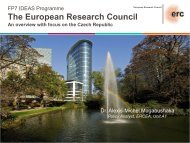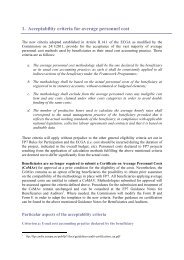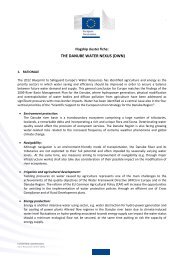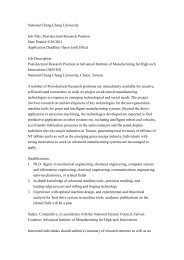Guide to Research and Innovation Strategies for Smart Specialisation
Guide to Research and Innovation Strategies for Smart Specialisation
Guide to Research and Innovation Strategies for Smart Specialisation
You also want an ePaper? Increase the reach of your titles
YUMPU automatically turns print PDFs into web optimized ePapers that Google loves.
• Higher impact of innovation investments thanks <strong>to</strong> a comprehensive strategy that<br />
combines R&D investments (e.g. in eco-innovation) with purchasing innovations (e.g.<br />
of energy efficient <strong>and</strong> low carbon buildings or transport),<br />
• Higher mobilisation effect on private inves<strong>to</strong>rs / venture capital, thanks <strong>to</strong> the faster<br />
market access <strong>and</strong> return-on-investment <strong>for</strong> innovative firms.<br />
Barriers <strong>and</strong> Challenges<br />
The main reasons why still <strong>to</strong>o few public procurers in the EU buy innovations <strong>and</strong> why the<br />
procurement of innovation is still hardly used as an innovation support <strong>to</strong>ol are:<br />
• Lack of or wrong incentives <strong>for</strong> public procurers: Procurers tend <strong>to</strong> favour low cost, low<br />
risk, <strong>and</strong> 'off the shelf' solutions once the (political) decision on what <strong>to</strong> buy <strong>and</strong> at<br />
which price has been taken even when there are longer term benefits <strong>to</strong> public service<br />
providers in testing <strong>and</strong> procuring new technologies <strong>and</strong> solutions,<br />
• Lack of knowledge of public procurers on what new technologies <strong>and</strong> innovations are<br />
available in the internal market or are possible <strong>and</strong> what could be the medium <strong>to</strong> longterm<br />
benefits <strong>and</strong> cost savings,<br />
• Lack of capabilities of public procurers <strong>to</strong> manage procurement procedures involving<br />
market consultations, competitive dialogues, cost-benefit evaluations, life-cycle costing<br />
assessments, etc,<br />
• Fragmentation in dem<strong>and</strong> <strong>and</strong> lack of critical mass: In general, individual procurements<br />
are mostly <strong>to</strong>o small <strong>for</strong> companies <strong>to</strong> make investments in innovations worthwhile.<br />
There are hardly any mechanisms <strong>to</strong> allow the pooling of risk <strong>and</strong> resources across<br />
countries <strong>and</strong> different administrations,<br />
• Difficulties <strong>for</strong> innovative SMEs <strong>to</strong> be involved in public procurement as direct supplier<br />
as shown by the EC study on SMEs access <strong>to</strong> public procurement 129 . This hampers the<br />
access of public authorities <strong>to</strong> the innovative potential of SMEs, in particular high-tech<br />
SMEs who play a key role in creating innovative solutions,<br />
• No strategy that links public procurement with other public policy objectives: the<br />
administrations in charge of e.g. health <strong>and</strong> care services, environment, mobility,<br />
energy, housing, waste <strong>and</strong> water management do not perceive themselves as having any<br />
role <strong>to</strong> play regarding support <strong>for</strong> innovative firms. On the other side, administrations in<br />
charge of research, innovation <strong>and</strong> business support do not include in their strategies the<br />
question of what innovative solutions the public sec<strong>to</strong>r would need <strong>to</strong> procure. In<br />
addition, the two sides of the administration do not develop jointly their strategies.<br />
How <strong>to</strong> act?<br />
The ERDF allows in a unique manner <strong>to</strong> strategically combine investments in R&D <strong>and</strong><br />
innovation capacity building with dem<strong>and</strong>-side measures. This is particularly true <strong>for</strong> public<br />
procurement, as the partnership contracts <strong>and</strong> strategic reference frameworks include different<br />
str<strong>and</strong>s of administration (e.g. environment, transport, industry, innovation) <strong>and</strong> allow <strong>for</strong> the<br />
development of strategies that cover entire countries (<strong>and</strong> even beyond).<br />
There<strong>for</strong>e, the European Commission recommends:<br />
129 http://ec.europa.eu/enterprise/policies/sme/business-environment/public-procurement/<br />
101

















